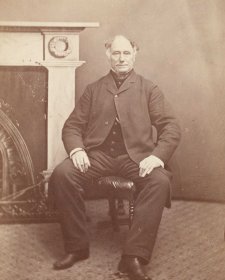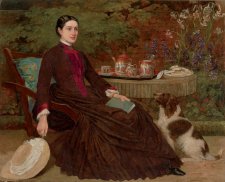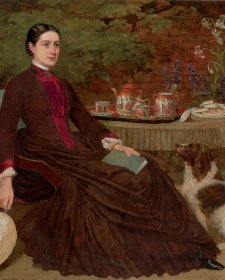William Robertson (1798–1874), pastoralist and entrepreneur, was a key player in the early settlement of Victoria. A farmer’s son, Robertson came to Van Diemen’s Land with his brother John in 1824. He initially took up land near Hobart before, in 1832, establishing Robertson Brothers, an emporium and importer of fine homewares, fabrics and other furnishings. In Campbell Town in September 1834 he married Margaret Whyte (1811–1866), the daughter of Scottish free settlers. By this time Robertson had amassed sufficient capital to join a number of other investors, including John Batman, in a scheme to expand pastoral activities into the unclaimed districts across Bass Strait. The consortium financed Batman’s exploratory trip to Port Phillip in 1835, during the course of which he made a ‘treaty’ with the Aboriginal people that he later used as the basis for a 600,000 acre land claim on behalf of the syndicate – the Port Phillip Association. Robertson travelled to Port Phillip in 1836 and again in 1837 to select his share of the land, his holdings by the late 1840s concentrated in the area around Colac. Robertson stocked his properties with ‘the best bulls and cows that could be got in the colonies’ as well as making return journeys to Britain to select livestock for export. He oversaw the operation of his pastoral empire from his home, Melrose, in Battery Point, until retiring from his Hobart business in 1852. The family settled permanently at Robertson’s Colac property, Corangamarah, later known as The Hill, in the early 1860s. On his death in 1874, Robertson was described as a ‘founder’ of Victoria’s fortunes: ‘He took an important part in its early struggles for existence, and never ceased his exertions in it until by his acumen, energy, and perseverance, his lands became a vast possession and himself a millionaire.’
Thomas Adams Hill was one of several photographers who emigrated to Victoria in the 1850s. Arriving in Melbourne around 1855, he worked with Townsend Duryea and Archibald Macdonald before setting up his own practice in Collins Street in 1856. Moving to a studio next door to the GPO on Bourke Street, in 1858 he advertised the implementation of various ‘improvements’, his services including daguerreotypes and ambrotypes as well as hand-painted photographic miniatures on ivory. For a while he worked in partnership with Montagu Scott, who was employed ‘to facilitate the execution’ of this ‘new style of PORTRAIT, combining the brilliancy of an oil painting with the invariable accuracy of a photograph.’ Hill is perhaps best known as the creator of the photographs of Robert O’Hara Burke and William John Wills which were taken shortly after both men had been appointed to the Victorian Exploring Expedition. Soon after their deaths were confirmed, The Argus reported that ‘we have received two excellent photographs, on a small scale, one of Burke and the other of Wills, which are now on sale at Hill’s Gallery, next the Post-office, in Bourke-street.’ Hill’s photographs of the explorers subsequently became the basis for the many commemorative portraits issued in the wake of their deaths.
Collection: National Portrait Gallery
Gift of Malcolm Robertson in memory of William Thomas Robertson 2018
Donated through the Australian Government's Cultural Gifts Program
Malcolm Robertson (16 portraits)



On one level The Companion talks about the most famous and frontline Australians, but on another it tells us about ourselves.



20 July 2023
To celebrate his family bicentenary, Malcolm Robertson looks at the portraiture legacy left by his ancestors.



Malcolm Robertson tells the family history of one of Australia's earliest patrons of the arts, his Scottish born great great great grandfather, William Robertson.